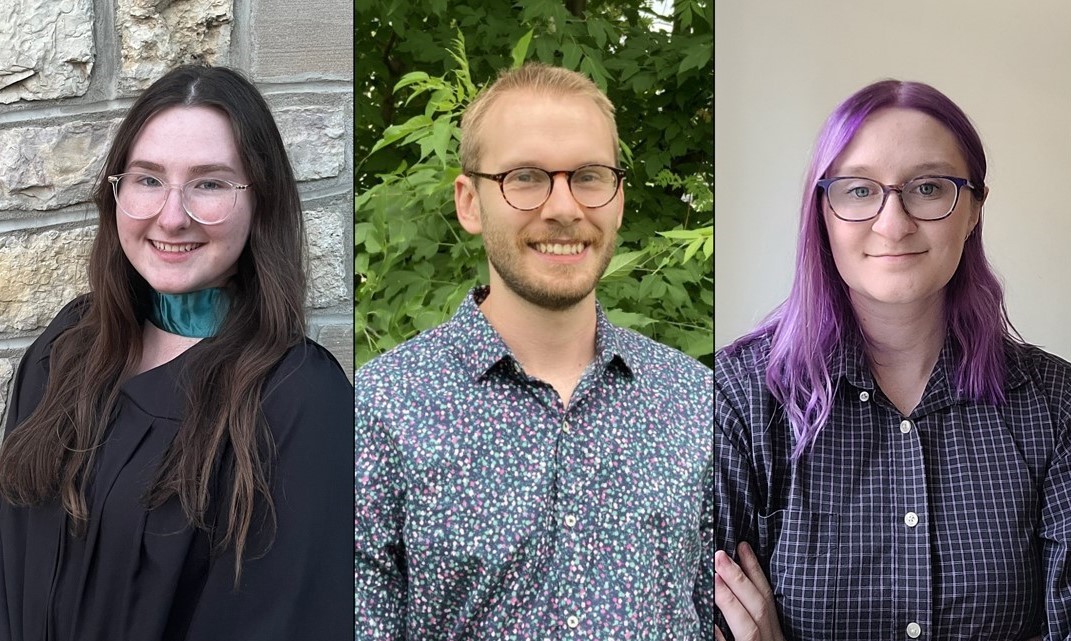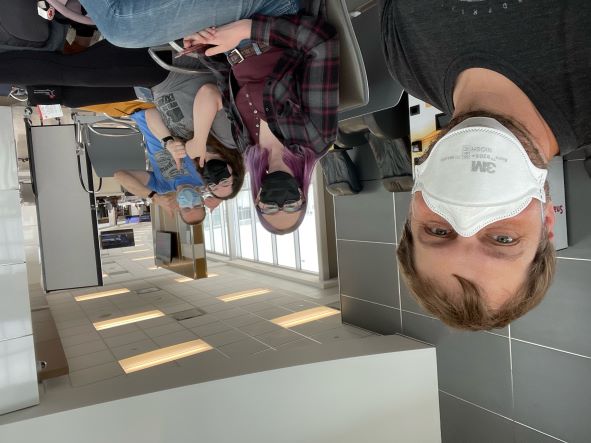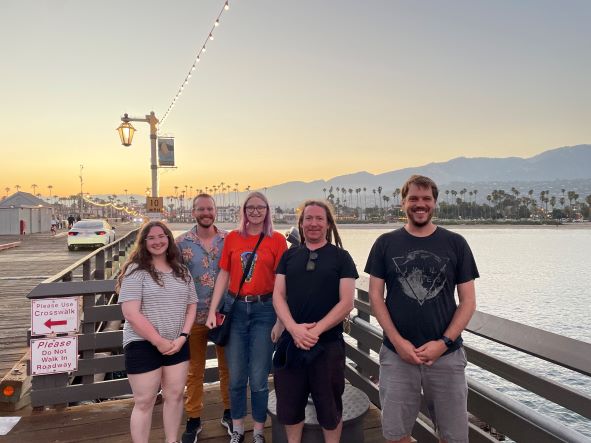
USask researchers present at international robotic telescopes conference
An undergraduate student, two new graduates and a lecturer from the Department of Physics and Engineering Physics attended the RTSRE conference in Santa Barbara
By Shannon Boklaschuk
A new robotic telescope installed two years ago at the Sleaford Observatory east of Saskatoon is changing the way teaching, learning and research is conducted in astronomy classes at the University of Saskatchewan (USask).
Earlier this month, an undergraduate student, two new graduates and a lecturer from the Department of Physics and Engineering Physics in USask’s College of Arts and Science had the opportunity to share their telescope-related projects with an international audience. With support from the department, they attended and presented at the Robotic Telescopes, Student Research and Education (RTSRE) conference, held in Santa Barbara, Calif., from June 21 – 23, 2022.
“It felt great to represent the University of Saskatchewan and share our findings with people from the U.S., Australia and the U.K. in person,” said Rina Rast, who attended the conference after receiving her Bachelor of Science (honours) degree in physics at USask’s spring 2022 Convocation in June.
“It reiterated that our research is important to the wider astronomy community,” she said.

USask astronomy students have been conducting original research since the PROMPT-USASK telescope was installed in the spring of 2020. Through an international network called Skynet, USask students can access telescopes in the United States, Australia and Chile as easily as they can access the PROMPT-USASK telescope located at the Sleaford Observatory east of Saskatoon.
For USask astronomy students, the robotic telescope enhanced online learning during the COVID-19 pandemic, since it can be controlled by any computer connected to the internet. In 2021, the telescope also received international attention when it discovered its first supernova—a giant explosion occurring at the end of the life of a star—thus enabling USask astronomers to explore new research.
“With everything that happened at the university regarding COVID and online schooling, and with the PROMPT-USASK telescope becoming operational, a lot of the focus in astronomy classes has shifted to using robotic telescopes,” said Alex Rosset, who also received a Bachelor of Science (honours) degree in physics at USask’s spring 2022 Convocation and attended the RTSRE conference in June.
“Attending this conference was, to me, an interesting way to see what other students, faculty and members of the public were doing with their own robotic telescopes,” she said. “It’s amazing to see how we’re moving forward in the field of astronomy.”
Rast and Rosset travelled to the RTSRE conference with undergraduate student Alexander Magnus and astronomy lecturer Dr. Daryl Janzen (PhD). Magnus, who is currently pursuing an honours degee in physics with a specialization in astronomy, wanted to attend to learn more about projects underway in the field of astronomy and to network and to find potential opportunities to pursue after completing his studies.
“I think it’s very important for students to attend events like this, especially if you plan on making a career in the field,” said Magnus.

As part of the conference lineup, Rast, Rosset and Magnus gave back-to-back presentations during the morning of June 22, while Janzen led a workshop and gave a talk about setting up and using a robotic telescope for university education.
“The workshop focused on a tool I’ve been working on with a team of people connected with Skynet to develop this past year, which essentially enables first-year undergraduate students to study star clusters and generate results in less than an hour’s worth of work that are often better than a grad student could have produced even a decade ago,” Janzen said.
“I piloted the tool in the winter term with my ASTR 113 class, and some of them even helped write code that was eventually implemented in the tool. It was really great to show this off last week as well.”
Janzen said showcasing student research is a key aspect of the RTSRE conference. As a result of attending, Rast, Rosset and Magnus were also able to meet some of their international collaborators in person as well as build new connections and explore new opportunities, he said.
“Educators and education researchers, observatory directors and software designers are all there talking about all the cool tools, facilities and student projects we’re creating—from Harvard to UCLA to Melbourne,” Janzen said.
Rast, Rosset and Magnus were pleased to have the opportunity to present their research and to travel to the conference in Santa Barbara. They were also grateful for Janzen’s efforts to make the opportunity possible.
“He arranged everything with RTSRE, and without him we wouldn’t even have access to robotic telescopes,” Rosset said. “He deserves my thanks for not only inspiring me to enter the field of astronomy, but for continuously supporting me in my journey.”

Magnus described Janzen as one of the best teachers he has had at USask, noting Janzen is “available and interested in helping his students at all times.”
“From my first class with him, I felt like I was truly participating in science, not just learning from the outside,” said Magnus. “Further, he’s constantly collaborating and finding opportunities with researchers everywhere to improve astronomy not just at USask, but worldwide.”
Rast, who will begin a master’s degree in astronomy at Western University in the fall, said USask has an amazing astronomy program, and it’s obvious Janzen cares about student involvement.
“Taking Daryl’s astronomy classes and doing my undergrad thesis in an astronomy topic enabled me to use telescopes around the world and was a rich educational experience,” she said.
USask presentations at RTSRE
Below, the USask researchers share key messages from the presentations they delivered at the RTSRE conference in June.
Rina Rast, “A Follow-Up Study of 485 Bright RR Lyrae Variables”
My presentation was based on my undergraduate honours thesis, which was supervised by Daryl Janzen. We investigated 485 of the brightest stars classified as RR Lyrae variables in the WISE catalog of periodic variable stars. We found that the catalog had misclassified 42% of these stars, in comparison to their published misclassification rate of 5%. The misclassification rate jumps to 94% if you look at the novel detections in the catalog. Our findings demonstrate that astronomers need much more robust classification strategies when creating these large variable star catalogs.
Alexander Magnus, “Investigating Variable Star Classification in Large Data Sets”
The main message of my talk was that we need to be very careful how we look through the vast swaths of astronomical data that are being collected worldwide. We need to utilize algorithmic approaches since there is just so much, but the methods we use must be sound. Before my project, Rina studied one specific variable star catalog and found that they had a 42% misclassification rate of RR Lyrae, which are a type of variable star. She also found that for previously undiscovered RR Lyrae stars their misclassification rate jumped to 94%. I looked at the techniques used by this catalog to classify RR Lyrae type stars and gave some insights into why they failed. I also studied a new method for classifying variables by building an algorithm which identifies secondary pulsations in the stars (for analogy, think of harmonic vibrations on a guitar or piano string). Although it did not end up being useful for classification purposes, it gave us previously unseen insight into variable stars beyond RR Lyrae.
There still needs to be a human eye looking through the data of each star; all the algorithms we have at our disposal aren’t yet cutting it when not coupled with a human observer. Each star is completely unique, which makes it difficult to abstract the classification process in a way that is fast and precise. Classifying these stars correctly has implications for other fields, such as cosmology, since they help us understand the distance scale of the universe. By increasing our classification accuracy, we also improve the accuracy of our model of the universe, which helps us to fine tune the details of how it all began.
Alex Rosset, “A Tool for Period-Luminosity-Metallacity-Extinction Analysis of RR Lyrae Variables”
Even if there is a set way to do things, never give up on finding alternate ways. The only way science can move forward is by constantly testing the boundaries of what we know. That, and bad data does not mean bad science. Null results are still results.


